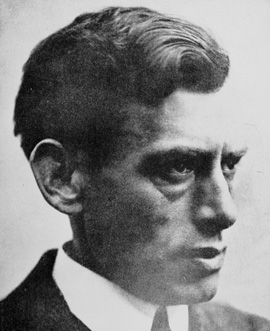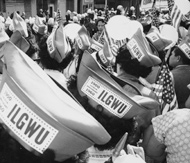

ILGWU Presidents
Benjamin Schlesinger
- Years in office: 1903-1904, 1914-1923, 1928-1932
- Born: December 25, 1876
- Died: June 6, 1932
- Nationality: Lithuanian
Benjamin Schlesinger was born December 25, 1876, in Krakai, Lithuania, in what was then Russia, the son of Nechemiah and Judith Schlesinger, and attended the local Cheyder. His grandfather, Simcha, was a Rabbi in Racinn, Lithuania. His father died when he was four and his mother some years later in 1909. He emigrated with an older brother to this country in 1891, settling in Chicago, and became an American citizen in that city on March 19, 1898. He was married to Rose Schenhause on August 27, 1899 in Chicago.
Schlesinger's first job after his arrival in Chicago was peddling matches but, a few weeks later, he was employed as a "floor boy" in a cloak shop. Two years later, when he was 17, and a sewing machine operator on ladies' cloaks and suits, he led his first strike, a successful one, in his shop. He was a delegate from Chicago to the convention, held at 125 Rivington Street, New York City, which founded the International Cloak Makers Union of America on May 1, 1892. Schlesinger, then only 16 years old, was elected treasurer. In 1895 he was elected recording secretary of the Chicago Cloak Makers Union, a post he held for at least three years. He became business manager and organizer of Local 5 of the Chicago Cloakmakers' Union in 1902 and, when the five Chicago locals united under a Joint Executive Board, he became manager of that organization.
In May 1903, Schlesinger was elected president of the ILGWU and, after only a brief term, became organizer for the New York locals in January 1904, in which post he stayed until 1907. For the period 1907 to 1912, he served as manager of the New York Jewish Daily Forward; while still in that position, he served as a member of the Strike Committee in the 1910 strike and later was appointed a member of the Board of Grievances (1911).
In June 1914, Schlesinger was once more elected president of the ILGWU and served until January 1923. During this period, other offices he held included the following: manager of the New York Joint Board, "without pay, temporarily," (1914); president, Needle Trades Workers Alliance (1920); member, general executive board, International Clothing Workers' Federation, Amsterdam (1919-23); delegate, American Federation of Labor, to British Trades Union Congress (1922); and member, People's Relief Committee (1917-22). Schlesinger served (1923-28) as manager of the Chicago office of the Jewish Daily Forward and was elected, for the last time, as president of the ILGWU in October 1928, serving until his death in June 1932. Benjamin Schlesinger was, at various times, a member of the Workmen's Circle, Forward Association, Socialist Labor Party and Socialist Party.
Among the proposals which Benjamin Schlesinger initiated and which were then or later adopted as policy by the Union, were the following: he introduced at the convention of 1902 a resolution urging locals to arrange bimonthly or at least monthly lectures and discussions on all educational subjects. At the 1903 convention, he introduced a resolution urging locals to establish sick-benefit funds. In 1914, he proposed special training of active workers for the Union and the International entered into an arrangement with the Rand School of Social Science for a course of studies for members of the New York locals. The program lasted for one year. The following year, June 28, 1915, in the midst of demonstrations and strike demands on the question of "hiring and firing," Schlesinger asked the Protective Association to submit the dispute to a committee of unbiased persons. As a result a Council of Conciliation was appointed by Mayor Mitchel and the strike was avoided. Another strike in Chicago that same summer was similarly avoided. In 1918, he successfully proposed that business agents be considered "experts" and appointed by the elected officers. He was also successful, in the period 1920-21, in dividing Local 25 into two groups of waistmakers and dressmakers, to accommodate the growing dressmaking section of the industry, resulting in the establishment of the New York Dress Makers' Union, Local 22, then the largest local union in the International. On July 1, 1920, Schlesinger addressed a letter to the Neckwear Workers' Union of New York, the International Journeymen Tailors' Union of America, the International Fur Workers' Union, the United Garment Workers of America, the Amalgamated Clothing Workers of America, and the United Cloth Hat, Cap Makers and Millinery Workers' Union of America, proposing an alliance of all garment workers unions. Discussions dragged on for several years but with only limited success. On November 15, 1921, Schlesinger laid the cornerstone of a new building at 3 W. 16th Street, NYC, which served as the union's General Office until it moved into 1710 Broadway in 1943.
He was the author of several pamphlets on the garment industry. He died on June 6, 1932. In 1967, the junior high school on New York Blvd., Jamaica, Queens, was named the Benjamin Schlesinger Junior High School in his honor.



